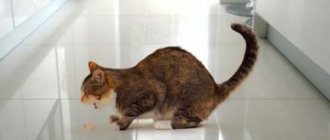Cats are very curious animals, especially small kittens who constantly want to find out something, smell and play with both butterflies and flying insects, including bees. Being a predator by nature, a cat, once outside, especially in the summer, begins to realize its predatory instinct, trying to catch bees crawling on the flowers of plants. If a cat has not previously interacted with bees, then this can end quite sadly for her. With the onset of the warm season, bees in search of nectar are regular visitors to flowering plants, and of course it is not the bee’s fault when a cat or kitten tries to play with it. Cat owners often do not know what to do if their pet is stung by a bee.
Symptoms of a bee sting in a cat . While you are in nature with your cat, where bees are flying in search of nectar, you notice that the cat suddenly begins to behave inappropriately. From a painful bee sting, the cat begins to run, rush, and climb into various places. During an external examination of their pet, the owners note that the cat is breathing heavily, suffocating, the bite site (nose or paw) is swollen, and the bite site is very painful. Increased salivation appears (the cat is drooling), lacrimation, after the bite the cat begins vomiting (the cat is vomiting), convulsions and an increase in body temperature.
With severe bee stings, a cat may develop anaphylactic shock.
Why do cats bite?
Cats can, of course, become aggressive when they are scared or feel threatened. But many also tend to bite and scratch when petted by their owner. This is called petting-induced aggression, and it has been a topic of discussion among behaviorists for decades. There are three theories why cats do this. First, they are simply letting their owner know that they are no longer happy to be petted. Secondly, they are trying to establish their status. Thirdly, a person who pets them for a while causes negative emotions in cats. It is important for owners to learn more about their cats in order to recognize the telltale signs of aggression caused by petting.
“Cat scratch disease” really exists!
Infections don't just come from cat bites, they can also come from cat scratches, causing an infection known as cat scratch disease. Approximately 40% of cats are infected with the bacteria Bartonella henselae, which they contract from flea bites and their droppings. When a cat scratches a person, B. henselae can enter the scratch and cause a localized skin infection as well as an infection that spreads to the lymph nodes located near the scratch. Symptoms of cat scratch disease may include: fever, fatigue, decreased appetite and headaches. Fortunately, cat scratch fever is rarely fatal, and symptoms are usually mild. The illness usually lasts from one to two weeks, although in some cases it has been known to take up to eight weeks. Symptoms usually go away on their own, but people with medical conditions may need medical attention.
First aid for cats with bee stings
Some tips when you notice a bite:
- If there is a sting, remove it immediately. The poison penetrates the circulatory system in 3 minutes. It is appropriate to use the sharp edge of a credit card or tweezers. Fingers can damage the sac of poison;
- After removing the sting, observe the reaction.
The reaction should be mild and localized; The result of a paw bite. - Sometimes the use of an antihistamine, diphenhydramine, is necessary. In this case, you need to consult a specialist, since many drugs contain painkillers. Even death is possible. The veterinarian will advise the correct remedy and dosage;
- applying a cold edema or cold towel will reduce minor swelling;
- if possible, do not allow scratching, as the pain will become stronger;
- calm your pet and give you the opportunity to rest.
Photos of cats stung by bees
In the photo you can see how swelling develops in cats bitten by bees.
The muzzle at the site of the lesion swells, the eye closes.
Important! When a bee bites a cat on the nose, it develops swelling not only on the skin, but also in the respiratory tract, which threatens the death of the animal.
Getting a sting in the face or cheek can also lead to serious swelling:
Why is a bee sting dangerous for cats?
Dangerous places for bee infestation in cats:
- nose;
- larynx;
- groin;
- eyes.
Important! After a bee sting, swelling develops, the consequences of which can be blindness, suffocation, difficulty urinating, which can lead to disability or death of the animal.
How does an allergy to bee stings manifest in cats?
Allergies in cats to bee stings occur with varying degrees of severity. In total, there are 3 types of allergic reactions based on intensity:
- A moderate reaction causes lethargy, the temperature rises, and the cat refuses food. At this stage, no treatment is required; the animal’s body will cope with the bee venom on its own.
- The average degree is manifested by swelling at the site of the lesion, blisters appear, the skin around the eyes and neck swells, unbearable itching (urticaria) appears, which can become acute and threatens the life of the animal.
- Anaphylactic shock is a severe reaction to an insect bite that develops within a few minutes and threatens the death of the cat. In this case, urgent veterinary care and intravenous administration of antihistamines are necessary.
Symptoms
The owner does not always have the opportunity to keep track of his pet, but based on his behavior he should suspect the fact of a wasp sting. The cat often meows pitifully, scratches, and licks the stung area. A more detailed examination of the lesion usually reveals a red spot, swelling, marks from claws, teeth, with which the animal wants to quench the itching that has arisen.
The degree of inflammation depends on the weight, age and type of insect that bit your pet. The most extensive swelling will appear in a kitten stung by a bee on the nose, cheeks or eyes. A wasp bite on the tongue is especially dangerous. The symptoms here are similar to those in humans:
- round redness;
- edema;
- burning, itching;
- pain.
An animal stung by an aggressive bee rushes around the corners, its behavior is restless, sometimes violent. When wasp venom gets into your cat's paw, lameness occurs. These signs are caused by a developing allergy to wasp toxin, which is accompanied by the above consequences, as well as:
- diarrhea;
- lacrimation;
- convulsions;
- swelling of the larynx;
- increased temperature;
- lack of appetite, weakness.
In mild cases of a wasp or bee sting, all signs disappear on their own after a few days. But in view of the existing danger of damage to your pet’s respiratory tract and the onset of suffocation, veterinarians recommend taking immediate action immediately after detecting a problem.
Allergy
Swelling from a bee sting is already a sign of a serious problem. If this is all you need to do, you can cope without specialized help. But when a tumor of the larynx, vomiting or diarrhea, and heart rhythm disturbances are added to this, it is worth talking about an allergic reaction. It is no longer possible to do without the use of antihistamines.
At home, homeopathic remedies such as Apis tablets will help prevent the development of a reaction when a cat is stung by a bee. You can also give Tavegil, Suprastin, Diazolin or Diphenhydramine.
If a bee gets stung in the face or enters the oral cavity, it is recommended to use the following remedies:
- a Prednisolone tablet is crushed into powder, diluted with water and poured into the cat’s mouth; if this option does not help, take the drug in an ampoule and inject the medicine;
- if you have nausea, vomiting, or difficulty breathing, you will need a Dexamethanose injection;
- If you are allergic to bee stings, L-cet suspension helps.
If these medications do not provide relief and the allergic reaction continues to worsen, medical attention will be needed.
L-cet
Prevention
It is impossible to protect four-legged pets from stinging insects with a 100% guarantee. But if your pet spends the summer at the dacha, you should take care to reduce the likelihood of a bite to a minimum. Reasonable measures would be:
- Premises protection (mosquito nets).
- Treatment of the territory (destruction of wasp nests).
- Do not place bowls of water or food outside or on the veranda.
- Treating animals with repellents.
Can cats have allergic reactions to bee and wasp stings?
Cats stung by bees or wasps can develop severe and life-threatening reactions if they are allergic to the insect venom. This reaction is most often seen in cats that have been stung previously. This is the result of the cat becoming “sensitized” to the bite and the immune system overreacting the second time around. Anaphylaxis is an emergency and can be fatal if your cat does not receive prompt veterinary treatment, which usually includes supplemental oxygen, an IV, and medications such as epinephrine, steroids, and antihistamines.
Contacting a veterinarian
Clear signs of an allergic reaction are already a reason to show the stung cat to a doctor. If you have symptoms of anaphylactic shock, this should be done immediately (every minute counts here).
Important! If a bee stings, kittens under six months of age must be taken to the veterinarian immediately. Children are more susceptible to severe consequences from bee stings than adults.
A single bee sting can already be dangerous for a pet. And if a cat is attacked by several insects, then it may well develop severe intoxication, which can lead to death.
Going to the vet
First aid
If a bee stings, its sting remains in the body. The slightest touch to it increases the pain. Therefore, it is so important to locate the bite site and remove the sting from the cat.
This must be done extremely carefully, otherwise the sting will break and its poisoned tip will remain under the skin. In this case, it is more difficult to remove the fragment. You may even need surgery.
The place where the cat was bitten by a bee is treated with an antiseptic. This will help reduce inflammation. A cold compress is then applied to the swollen area.
Antiseptic
Recognizing the signs of a bite
In most cases, cats exhibit a localized reaction where the bite area becomes slightly swollen and tender. Often, a bee or wasp can sting in the face, usually in the nose area, or in the paw. Check to see if the sting remains on the skin. When a bee stings, it leaves a sting with spikes in the body of the victim. Wasps do not lose their stings, so they can sting a victim several times in a row, which increases the degree of threat to your pet.
Severe swelling, redness and pain are the first signs of an acute reaction. The animal may show that it is in pain, for example, it will begin to limp or hobble, meow loudly, or vigorously lick the bite site. The following symptoms are observed in anaphylactic shock:
- Rash.
- Disorientation or stumbling.
- Vomiting or diarrhea.
- Pale gums.
- Low body temperature and cold extremities.
- Fast or slow heart rate.
According to the North Asheville Veterinary Clinic, other signs to watch for include fainting, shallow or rapid breathing, increased salivation, changes in behavior, mood, and thinking abilities. If any of these signs occur, take your pet to a veterinarian immediately.
What not to do
When helping a cat after a wasp sting, it is important not to harm it. What not to do:
- apply a cloth moistened with dirty water from a pond or reservoir to the wound;
- lubricate the bite site with irritating ointments that contain essential oils or menthol;
- independently resuscitate your pet if there are symptoms of anaphylaxis;
- giving your cat pills intended for humans without your veterinarian's permission;
- You should not allow your cat to scratch the lump; you may have to wear a protective collar.
Disinfestation products
You can treat the wound if a bee has stung a cat with medical alcohol, ammonia, any alcohol tincture, or hydrogen peroxide.
- Tincture of valerian, motherwort, and calendula soothes pain and relieves swelling. A small amount is applied to a cotton swab and applied to the sore spot.
- If there is no alcohol, prepare a paste from soda. Mix kitchen salt and baking soda in equal proportions, dilute with a little water to form a paste. Apply to the skin. Baking soda helps relieve swelling, pain, burning, itching.
- You can disinfect the wound with juice from orange, lemon, onion, and potato. Another effective remedy is laundry soap or an acidic solution. Table vinegar and citric acid are added to the water. They make lotions, apply a compress, wipe the skin.
In the future, to eliminate swelling, decoctions of medicinal herbs are used - chamomile, mint, lemon balm, calendula. The potion is poured with boiling water and left for half an hour. Sore spots need to be treated several times a day. The swelling goes away completely within 3 days.
Interesting!
The cat actively licks the bitten area with its tongue. Not only because the animal is in pain or unpleasant, but to disinfect the wound. Saliva is a natural antiseptic. Wild, stray cats treat themselves. The sting falls out over time without outside help.
Treatment of a cat after a bee sting
A cat's reaction to a bee sting usually goes away within a week. Soreness and swelling are gradually replaced by itching. If the cat begins to scratch the itchy area with its claws, there is a risk of secondary infection. To avoid suppuration and the development of ulcers, wounds after a bite should be treated daily to reduce itching.
For this purpose, you can use topical creams and ointments: Zvezdochka balm, Fenistil Gel, Beinval. Medicinal plants are sometimes used:
- juice of fresh parsley leaves;
- leaf of plantain, yarrow;
- dandelion roots;
- tansy decoction.
Can be used:
- lemon slice;
- a piece of raw potato;
- aloe juice;
- chopped onion, garlic;
- salty water.
These medications are applied to the bite site, lotions and compresses are made. If the condition of the sore spot does not improve within 3 days, you should seek help from a veterinarian. In most cases, to alleviate the suffering of a pet, it is enough to provide first aid and monitor the cat’s well-being for several days.
When, as a result of a bee sting, a cat urgently needs to contact a veterinary clinic
Cats, like dogs, can experience a severe allergic reaction, including anaphylactic shock, as a result of a bee sting. If a severe allergic reaction occurs, we may be talking about saving the animal and urgently going to a veterinary clinic.
Symptoms of anaphylactic shock in a cat:
The cat develops severe painful itching in the muzzle area. The cat suddenly begins to squat, rubbing its eyes, ears and muzzle with its paws. Often the cat does this all very furiously, meowing in bewilderment. As a result of the onset of bronchospasm and venous stagnation in the pulmonary circulation, the cat develops severe difficulty breathing. The visible mucous membranes of the head instantly turn blue and become cold to the touch. Subsequently, the cat develops swelling of the larynx, breathing becomes hoarse and intermittent. If emergency assistance is not provided, the cat will die from suffocation.
In addition, you must contact a veterinary clinic:
- When a bee stings in the throat area or when a kitten swallows a bee.
- The cat was attacked by several bees.
- Very severe swelling at the site of the bee sting.
- If a bee stings a small kitten, there is a high probability of developing anaphylactic shock.
- The cat showed signs of suffocation, vomiting and coughing.
- Increased salivation.
- The bee sting is stuck in places that are difficult to reach and there is no way to remove it yourself.
- The cat's body temperature rose sharply.
- The cat behaves inappropriately, has seizures and loses consciousness.











